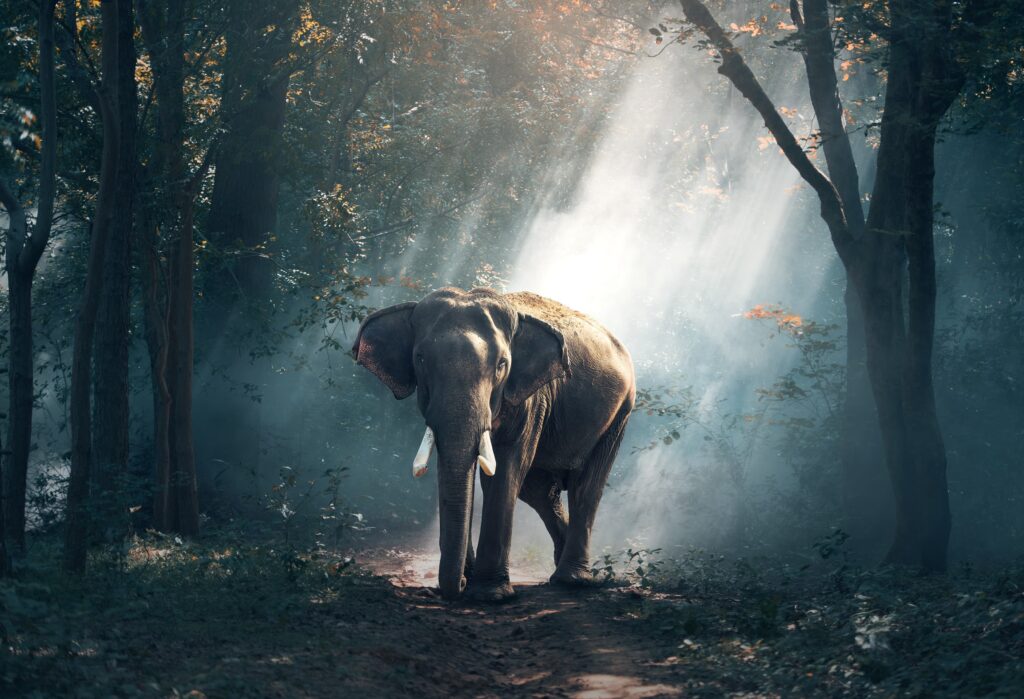The Bengal tiger (Pathera tigris tigris or Pathera tigris bеngalеnsis) is a subspecies of tiger belonging to the order of predators, family Catidae and genus Panthera. Bengal tigers are the national animal of historical Bengal or Bangladesh, as well as China and India.
Description of the Bengal tiger
The distinctive features of the Bengal tiger are its retracted type, sharp and very long claws, as well as its well-fluffed tail and incredibly powerful jaws. Among other things, the predator has perfectly developed hearing and eyesight, so these animals are able to see perfectly even in complete darkness. Length of a jump of an adult tiger is 8-9 m, and speed of movement at short distances reaches 60 km/h. Adult Bengal tigers sleep for about seventeen hours a day.
Appearance
The color of the Bengal tiger’s fur ranges from yellow to light orange in color, and the stripes on its fur are dark brown, bitter chocolate, or black. The belly area of the animal is white, and the tail is also predominantly white, but with distinctive black rings. The mutation of the Bengal subspecies, the white tiger, is characterized by dark brown or reddish-brown stripes on a white or light background. It is extremely rare to find absolutely white tigers without any stripes on their fur.
The average body length of an adult male Bengal tiger with tail is 2.7-3.3 m or more, and 2.40-2.65 m for females. The tail is maximal 1.1 m long and the height at withers is within 90-115 cm. Presently, Bengal tigers have the largest canines of all known representatives of the feline family. Their length can exceed 80-90 mm. The average weight of mature adult male tigers is 223-275 kg, but body weight of some, especially large specimens, reaches even 300-320 kg. The average weight of an adult female is 139.7-135 kg, and her maximum body weight reaches 193 kg.
Lifestyle, behavior
Predatory animals such as Bengal tigers live mostly alone. Sometimes, for a particular purpose, they are able to gather in small groups of a maximum of three or four individuals. Each male tiger fiercely guards his territory, and the roar of the enraged predator can be heard even at a distance of three kilometers.
Bengal tigers lead a nocturnal lifestyle, and during the daytime, these animals prefer to gain strength and rest. Strong and agile, a very fast predator, coming out to hunt at dusk or dawn, rarely remains without prey.
The area of one individual plot of raptor occupies an area of 30-3000 km2, and borders of such a plot are specially marked by males with their feces, urine and so called “scrapes”. In some cases the territory of one male partially overlaps with the territory of several females which are less territorial.
Longevity
“Bengals” prefer hot and humid climatic conditions, in which the average life expectancy is about fifteen years. In captivity, such strong and powerful predatory animals easily live to the age of almost a quarter of a century.
The white Bengal tiger
Of special interest is a small population of the white variation of the Bengal tiger (Pranhera tigris tigris v. Alba), bred by foreign scientists as a decoration for zoological parks. In the wild, such individuals would not be able to hunt in the summer, so they are practically not found in the wild. Occasionally appearing white tigers in their natural habitat are individuals with an innate type of mutation. Such a rare coloration is explained by specialists in terms of insufficient pigment content. The white tiger differs from its redskinned brethren in the unusual blue coloring of its eyes.
Habitat, habitat
All currently known subspecies of tigers, including the Bengal tiger, have a fur coloration that matches all the features of their natural habitat. The predatory species is widespread in tropical jungles, mangrove swamps, savannahs, and rocky areas up to three thousand meters above sea level.
Bengal tigers inhabit the territory of Pakistan and Eastern Iran, Central and Northern India, Nepal and Bhutan, as well as Bangladesh and Myanmar. Predatory animals of this species are found in the vicinity of the Indus and Ganges River estuaries, the Ravi and the Sutlij. The population of this tiger is less than 2.5 thousand individuals, with a probable risk of decline. Today, the Bengal tiger belongs to the category of numerous subspecies of the tiger and has been completely exterminated in the territory of Afghanistan.
